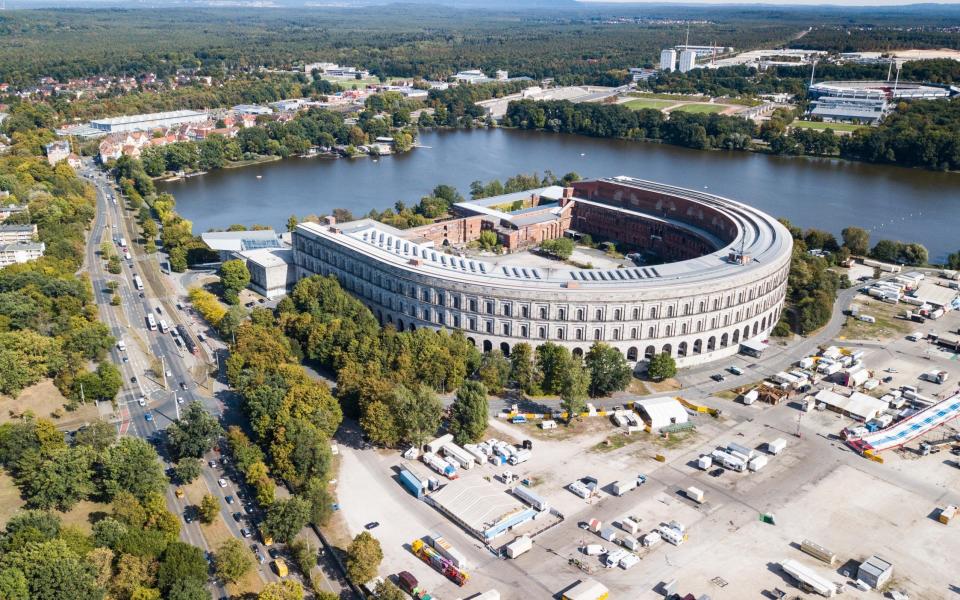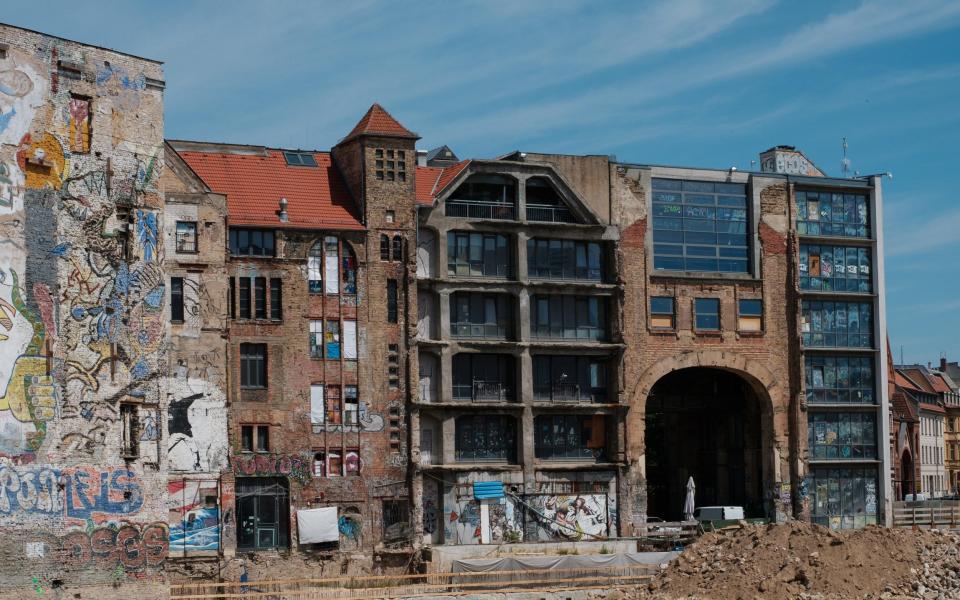When audiences enter Nuremberg’s Staatstheater in four years’ time, they will find themselves in an 800-seat cube swathed in lush greenery. To get there, they will have to walk through a giant horseshoe-shaped building best known as the “Nazi Colosseum”—one of the largest structures still standing from the party’s building spree of the 1930s, where millions gathered in open-air rallies to cheer on Hitler’s plans for domination and extermination.
This month, the city of Nuremberg announced that the opera’s temporary residence would be given a permanent £70 million home in the courtyard of the congress hall from 2021, in a major project funded primarily by the state of Bavaria, the federal government and the European Union. The decision has fueled tensions between those who believe the blighted buildings can be permanently reused, and others who want them left as memorials or demolished.
“Some would say that this is not something that should be done there, and that high culture has no place in a place where the Nazis made their most barbaric speeches,” says Tobias Reichard, director of the Ben-Haim Research Centre (BHRC) at the University of Music and Theatre Munich.
He takes a different view. Working at the BHRC, which is housed in the Führerbau (or “Führer Building,” which was used extensively by Hitler), Reichard knows firsthand what it’s like to sit every day within walls that are “deeply tainted” by their history. He sees the division over the new plans, which one conservative German newspaper called “cowardly,” as an opportunity to ask: “What should we do with this Nazi past, and how relevant is it today?”
The Nuremberg Rally Grounds were designed by Albert Speer, Hitler’s architect, with Ludwig and Franz Ruff responsible for the congress hall within. Inspired by Rome’s Colosseum and originally planned to reach 230 feet, the structure was only built to about half that height before work was halted by the outbreak of war. It has lain largely unused since the mid-1940s.

The opera house will, according to State Director Jens-Daniel Herzog, be a “permanent exorcism” of what came before — useful, Reichard believes, to ensure that the building’s roots are never forgotten. Herzog called the decision “a great signal because it shows us that Nuremberg not only has ideas, but also the courage to step into the future. This gives us great hope for future development potential.”
Others are less enthusiastic, calling the project “very questionable,” including Michael Steinberg, a professor of music and German studies at Brown University. “A permanent opera house in that kind of context has a very large shadow over it,” he says. That shadow will affect both the art and the institution, he believes, and both could suffer.
“You have this extremely charged building … where its use was central to the proclamation of Nazism. So this is a very powerful kind of alchemy,” he says. “Either I, as an audience, am being asked to ignore and suppress the obvious reality around me, or I am being asked to have a very confusing experience.”
He also sees a broader problem “with repurposing a space like that for pleasure, and in a way I can imagine it’s a sickening problem when it’s doing light Italian opera. In other words, are they going to do The Barber of Seville in a place that’s as creepy and as burdened with history as a place like that?” That the building is contaminated – and everything in it contaminated – is “inevitable – and the question is, what’s the point of that for opera culture in general?”
Which raises another problem. While Germany has spent decades reckoning with its old buildings—including turning Tacheles, a former prison, into a commercial art gallery; Prora, the future Nazi holiday camp, into luxury apartments; and the Saalecker Workshops, home of Paul Schultze-Naumburg, one of the party’s leading architects, into a design school—opera, too, bears the scars of the country’s past.


That, inevitably, is thanks to Hitler, an avowed fan who described in his 1925 autobiography, Mein Kampf, how he saw a life-changing performance of Wagner’s Lohengrin at the age of 12. Hitler attended operas almost daily during his four years in Vienna in his early twenties; had Richard Wagner’s four-and-a-half-hour epic Die Meistersinger von Nürnberg performed at the Berlin State Opera to announce the founding of the Third Reich in 1933 (the ensemble was Hitler’s own hand-picked selection); and the following year he ordered the rebuilding of the Nuremberg Opera House, so important was he to the art form. A signed manuscript of Wagner’s Rienzi is said to have ended up in the bunker where the Führer committed suicide.
In addition to his personal interests, opera proved a useful political tool. “The Nazis were of course well aware of the potential of music as a propaganda medium, and they used it very often,” says Reichard, co-author of Hitler. Power. Opera: Propaganda and Musical Theatre in Nuremberg , — primarily through Wagner, who forever entangled Hitler with his own political goals. The composer, who died 50 years before the Third Reich was founded, made no secret of his anti-Semitism (including his essay On Jewishness in Music , in which he bemoans the effect of the “essence” of Jews on the art form); his works, aimed at preserving German culture, seemed to Hitler to be his own ideas like a theatrical score. (In 1949, Thomas Mann, an arch-critic of Hitler, wrote that “it’s all there, in Wagner’s boasting, his constant lecturing, his desire to deliver monologues on every possible subject, an unspeakable immodesty – all that a role model for Hitler – there is certainly enough ‘Hitler’ in Wagner.”)
Still, “the Nazis are not Wagner’s fault,” says Steinberg, who co-curated a Wagner exhibition at the German Historical Museum in Berlin two years ago. “But the Nazis were very powerful manipulators of emotions, and they have that in common with Wagner.” Manuel Brug, opera critic for the German daily Die Welt, says Wagner is more popular in Germany than ever – and believes that every opera should be judged on its merits, rather than colored by its surroundings. “It’s a world of theater, and hopefully magic, that continues [in an opera] …So I don’t have any dark feelings and I don’t see any shadows from the past’ when I look into a reclaimed space, he says.


Part of the reason these debates keep cropping up is because Nazi buildings “are in dire need of rebuilding or they will collapse,” Reichard notes. Letting them fall into disrepair is not helpful; destroying them outright is not cheap, and it won’t silence the group that denies that Nazi atrocities ever took place. Can consensus ever be reached?
“How do we move forward? Do we always have to contextualize it? What happens if we don’t contextualize it?” Reichard says of the riddles of “guilty” buildings. “It shows us that there are relevant and crucial questions that need to be answered.”
Brug adds that there is value in a memorial that is different—brighter—than many others. “It is necessary to have something to remember, and not just in the dark places of the concentration camps.” He calls the renovation of Congress Hall a “win-win”—namely because the agreement will last for at least 25 years, providing a continuity that can help overwrite what has come before.
This won’t be the last time such a debate will take place in Germany – a prospect that Reichard welcomes. “Every generation has to decide anew what to do with this. It’s not so much about what our guilt is – do we feel guilty – but what can we learn from this from today’s perspective? If you ask me, I would try to never end this discussion, because it’s so illuminating.”